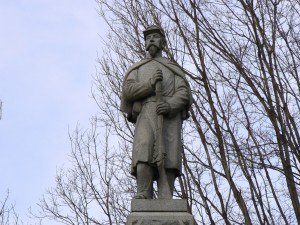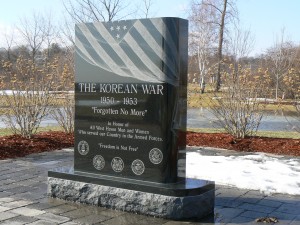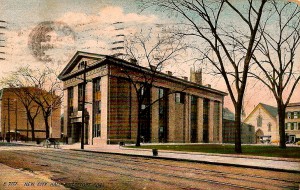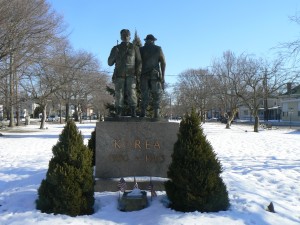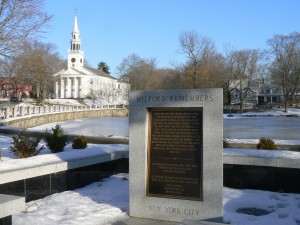 The Soldiers’ Monument on Naugatuck’s Town Green was dedicated in 1885 to honor local residents who served in the Civil War.
The Soldiers’ Monument on Naugatuck’s Town Green was dedicated in 1885 to honor local residents who served in the Civil War.
The monument, which sits at the center of the green, features a granite shaft topped by a statue of a caped infantryman resting with a rifle. The front (east) face of the monument lists the battles of Fort Wagner (S.C., near Charleston), the Wilderness (in central Virginia) and Cedar Mountain (Va.). Just above the base is the dedication by the people of Naugatuck “in memory of her sons who fought to maintain the Union 1861-1865.”
The south face (to the soldier’s right) doesn’t list any battles, but does ask that the “God of nations preserve our country in the bond of peace now established,” a message that reflects the broader spirit of reconciliation the country was experiencing during that era. By then, the post-war bitterness of Reconstruction had started to fade, and preservation efforts were being made at major battlefields such as Gettysburg.
The rear (west) face of the monument lists the battles of Chancelorsville (Va.), Petersburg (Va.) and Antietam (Md), as well as a dedication to “the citizen soldier, fearless in war, industrious in peace.”
 The north face lists the battles of Malvern Hill (Va.), Getttysburg and Atlanta, and a message reminding us that “the deeds of those who died in defense of the government of the people are immortal.”
The north face lists the battles of Malvern Hill (Va.), Getttysburg and Atlanta, and a message reminding us that “the deeds of those who died in defense of the government of the people are immortal.”
The Naugatuck monument is enclosed with a circular planting bed, and a stone fountain sits immediately behind the monument. Further back, across Meadow Street, is Salem School, which was built in 1893 and is itself listed on the National Register of Historic Places.
The vintage postcard depicting the monument was postmarked in 1905 and mailed to the Woodmont section of Milford.
Tags: Naugatuck
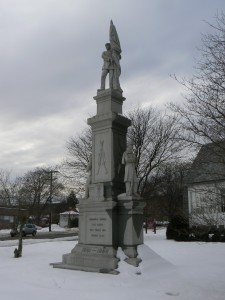 The Soldiers’ Monument in the Unionville section of Farmington was dedicated in 1916 to honor residents of the village who served in the Civil War.
The Soldiers’ Monument in the Unionville section of Farmington was dedicated in 1916 to honor residents of the village who served in the Civil War.
The monument features three figures — a standard-bearer stands atop the column, while its base is flanked by an artillery soldier on one side and an infantryman on the other. Infantry, artillery, calvary and naval symbols grace the column. The front column also features the logo of the Grand Army of the Republic, the Union veterans’ fraternal organization.
The front of the base is inscribed with “Unionville honors the earth that wraps her heroes’ clay.”
The monument was funded primarily by Captain Nathaniel C. Hayden, a veteran of the 16th Regiment Connecticut Volunteers who was wounded in the battle of Antietam. Capt. Hayden was a successful local businessman who lobbied for funds to build the monument. Eventually, he had it built himself. Fortunately, he lived long enough to attend the dedication.
The monument sits near the First Church of Christ Congregational at the intersections of Main Street (Route 4), School Street and Lovely Street (Route 177).
 Diagonally across the intersection is a memorial to 19 Unionville residents who died in the two world wars, Korea and Vietnam.
Diagonally across the intersection is a memorial to 19 Unionville residents who died in the two world wars, Korea and Vietnam.
The name for the village of Unionville refers to its location near the corners of the towns of Farmington, Avon and Burlington.
Sources:
Connecticut Historical Society: Civil War Monuments in Connecticut
Tags: Farmington, Unionville
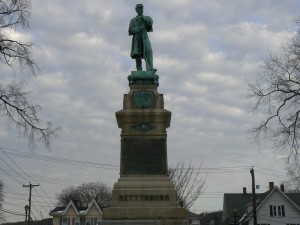 Derby’s Civil War monument, on the Elizabeth Street side of the town green, honors soldiers from Derby and Huntington (a predecessor of today’s city of Shelton) who served and died in the war.
Derby’s Civil War monument, on the Elizabeth Street side of the town green, honors soldiers from Derby and Huntington (a predecessor of today’s city of Shelton) who served and died in the war.
The Derby monument has two dedication dates. The base was dedicated in 1877. Six years later, after additional funds were raised, the based was remodeled and the infantryman statue was added. (As a side benefit, this allows you to have two dedication ceremonies, as well as the associated parades and parties.)
Even without the figure, the monument would be impressive. The front and rear plaques honor the men of Derby and Huntington who fell during the war of the rebellion, and the side plaques list about 81 names and regimental affiliations of local residents killed during the conflict.
 One side also features a brief excerpt from the “Bivouac of the Dead” poem by Theodore O’Hara, which appears on plaques and monuments in many National and Confederate cemeteries.
One side also features a brief excerpt from the “Bivouac of the Dead” poem by Theodore O’Hara, which appears on plaques and monuments in many National and Confederate cemeteries.
The base has raised inscriptions listing the battles of Atlanta, Chancellorsville (Va.), New Bern (N.C.) and Gettysburg.
The four cannons at the base of the Derby monument are 30-pounder Parrott rifles that were manufactured in 1861 at the West Point Foundry in Cold Spring, New York. Similar cannons can be found at the Civil War monument in Seymour, which will be profiled in a future post.
The Derby Green also features monuments to local veterans of the world wars, Korea and Vietnam, as well as a second memorial listing nine residents who were killed in Korea and Vietnam. A bell at the southwest corner of the green honors local firefighters.
Source:
Connecticut Historical Society: Civil War Monuments in Connecticut
Tags: Derby
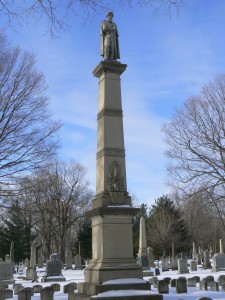 The Knight Hospital Monument in New Haven’s Evergreen Cemetery was dedicated in 1870 to honor the 204 wounded Civil War veterans who died in the hospital and were buried near the monument.
The Knight Hospital Monument in New Haven’s Evergreen Cemetery was dedicated in 1870 to honor the 204 wounded Civil War veterans who died in the hospital and were buried near the monument.
The fact that the monument is not dedicated to veterans from a specific town or regiment makes it very uncommon among Civil war monuments.
The monument’s column, topped by a bearded soldier, also bears shields with Connecticut and U.S. emblems as well as the names of several important battles, including Gettysburg, New Bern (N.C., spelled as ‘New Berne’), Fort Fisher (N.C) and Fredericksburg (Va).
More than 120 graves of Civil War veterans are located around the base of the monument, which is located on the Winthrop Avenue side of Evergreen Cemetery.
Knight Hospital was a temporary facility that opened in 1862 to treat soldiers wounded in the Civil War. The U.S. government leased a building from New Haven’s State Hospital, a predecessor of today’s Yale-New Haven Hospital. The hospital was named after Jonathan Knight, president of General Hospital Society of Connecticut’s board and a professor at the Medical Institution of Yale College.
Knight Hospital treated more than 25,000 patients during the Civil War, which impressed us if you consider the difficulty of transporting wounded soldiers from North Carolina or Virginia back to Connecticut while during a time of war.

Sources:
Connecticut Historical Society
New Haven’s Hospitals Exhibit (Cushing/Whitney Memorial Library)
Tags: New Haven
 On President’s Day, we’re highlighting West Haven’s Veterans’ Walk, a collection of monuments and tributes at Bradley Point that was dedicated in 2007.
On President’s Day, we’re highlighting West Haven’s Veterans’ Walk, a collection of monuments and tributes at Bradley Point that was dedicated in 2007.
The largest monument in the Veterans’ Walk collection features four black granite slabs that are dedicated to the local residents who served and died in the Vietnam War. Three large, slanted panels list about 282 names of residents who served, including six who were killed in the conflict. In front of the tablets, at the base of three flagpoles, are pillars with the emblems of the country’s military service branches, as well as a larger tablet etched with a map of Vietnam and the inscription “All gave some, some gave all.”
Two matching black granite monuments are located near the Vietnam memorial. One is dedicated to the residents who served in the Korean War. The other is dedicated to William A. Soderman, who was awarded the Medal of Honor for defending an important road junction against German tanks in 1944 with bazooka fire.
 Also near the monuments are a series of smaller pillars displaying the logos of veterans’ organizations from all of the wars fought by the United States.
Also near the monuments are a series of smaller pillars displaying the logos of veterans’ organizations from all of the wars fought by the United States.
The sidewalks leading visitors through the Veterans’ Walk area are lined with commemorative bricks bearing the names of local veterans.
Not far from Veteran’s Walk is a monument dedicated to the victims of the September 11, 2001, terrorist attacks, as well as a monument to the veterans from West Haven’s First Avenue who fought in World War II. West Haven has a collection of World War II monuments in several locations that will be featured in a future post.
Bradley Point, located on the west shore of New Haven harbor, sits next to the Savin Rock area that hosted seaside amusement parks until urban redevelopment efforts were launched in the 1960s.
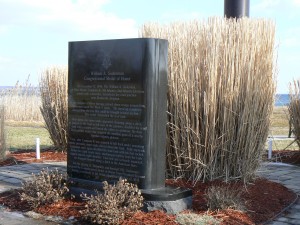 Bradley Point was also a landing area for British troops who invaded New Haven in 1779. The Defenders’ Monument dedicated to colonists who resisted that invasion was highlighted in a post on January 28, 2009.
Bradley Point was also a landing area for British troops who invaded New Haven in 1779. The Defenders’ Monument dedicated to colonists who resisted that invasion was highlighted in a post on January 28, 2009.
Tags: Medal of Honor, West Haven
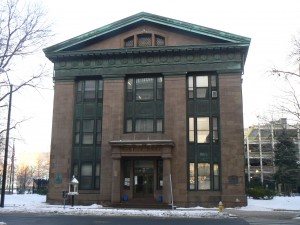 McLevy Hall in downtown Bridgeport, which traces its roots to 1854, once featured a hall that hosted a speech by then-Senator Abraham Lincoln on March 10, 1860.
McLevy Hall in downtown Bridgeport, which traces its roots to 1854, once featured a hall that hosted a speech by then-Senator Abraham Lincoln on March 10, 1860.
McLevy Hall, near the corner of State and Broad streets downtown, was originally built to serve as the Fairfield County Courthouse. Portions of the building contained offices for the city of Bridgeport. An auditorium known as Washington Hall used to be part of the complex, and was the site of Lincoln’s final political speech in the early stages of the 1860 presidential campaign.
Lincoln came to Bridgeport as part of a speaking tour of New England immediately after his February 27 speech at New York’s Cooper Union outlining his opposition to the expansion of slavery into new U.S. territories. From New York, Lincoln spoke at several locations in New Hampshire, Massachusetts, Rhode Island and Connecticut before arriving in Bridgeport early on Saturday, March 10.
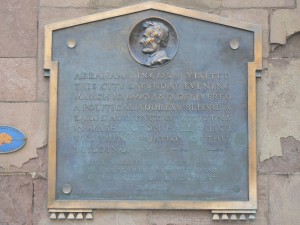 During the day, Lincoln hung out with local officials and delivered his address early in the evening before taking a 9:07 train back to New York. What the honorable gentleman from Illinois said in Bridgeport was not recorded. Most likely, his remarks had similar anti-slavery themes as his remarks in New York and New Haven, which were transcribed and published in local newspapers.
During the day, Lincoln hung out with local officials and delivered his address early in the evening before taking a 9:07 train back to New York. What the honorable gentleman from Illinois said in Bridgeport was not recorded. Most likely, his remarks had similar anti-slavery themes as his remarks in New York and New Haven, which were transcribed and published in local newspapers.
Lincoln’s speech is commemorated in a 1911 plaque on the State Street (south) side of McLevy Hall, near the front entrance.
The vintage postcard below was mailed from Bridgeport to New Haven in 1909.
The building, which today is used as a City Hall annex and contains several municipal departments, was renamed McLevy Hall in memory of Jasper McLevy, a Socialist who served as Bridgeport’s mayor from 1933 until 1957.
The building’s grounds also host the city’s World War (1933) and Vietnam (1983) monument. The plaque on the front of the World War monument appears to be a replacement.
Sources:
David W. Palmquist, Bridgeport: A Pictorial History, The Donning Company, 1981
http://www.abrahamlincolnsclassroom.org/index.asp
Tags: Bridgeport, Lincoln
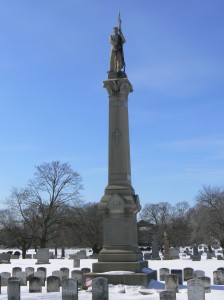 The Soldiers’ Monument in New Haven’s St. Bernard’s Cemetery was dedicated (most likely) in 1889 by the state of Connecticut to honor residents killed in the Civil War. The monument is different from many war monuments of the era in several ways.
The Soldiers’ Monument in New Haven’s St. Bernard’s Cemetery was dedicated (most likely) in 1889 by the state of Connecticut to honor residents killed in the Civil War. The monument is different from many war monuments of the era in several ways.
For example, the solider atop the monument is a flag-bearer, instead of the more common infantryman holding a rifle. In addition, the large cross on the front of the monument is unusual, and probably reflects the monument’s construction in a Catholic cemetery.
A stone eagle graces front side of the top of the column, beneath the soldier’s feet, and the other three sides have shields decorated with a stars-and-stripes motif.
The inscription on the front face of the monument dedicates it to the CT residents who gave their lives “that the Union should not perish.”
During the Civil War, Connecticut furnished 55,861 troops, sailors and marines to the Union effort, and 5,354 were killed in battle, or died of disease, as prisoners, in accidents or from other non-battle-related causes.
The area around the base of the monument in St. Bernard’s holds the grave sites of numerous veterans not only of the Civil War, but also other conflicts.
 St. Bernard’s Cemetery is within eyesight of the Defenders’ Monument profiled on January 28, 2009.
St. Bernard’s Cemetery is within eyesight of the Defenders’ Monument profiled on January 28, 2009.
Sources:
CT Historical Society: Civil War Monuments of Connecticut
Tags: New Haven
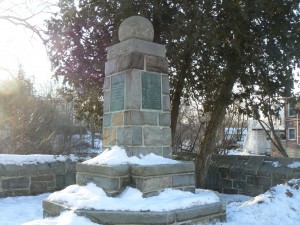 We conclude this week’s look at monuments in downtown Milford with a 1939 monument to three Milford residents who served the state of Connecticut as governors. The monument sits on a bridge across the Wepawaug River (named after the native settlers who sold Milford to colonists), northeast of the City Hall we featured earlier this week.
We conclude this week’s look at monuments in downtown Milford with a 1939 monument to three Milford residents who served the state of Connecticut as governors. The monument sits on a bridge across the Wepawaug River (named after the native settlers who sold Milford to colonists), northeast of the City Hall we featured earlier this week.
Plaques on the north, south and west faces of the monument’s column outline the political career highlights of the three Milford governors:
- Robert Treat (1622-1710) was one of Milford’s founders, and served as governor from 1683 until 1698. Treat was also a co-founder of Newark, NJ between 1665 and 1672.
- Jonathan Law (1672-1750) served as governor from 1742 to 1750.
- Charles Hobby Pond (1781-1861) served as governor from 1853 until 1854.
All three men are buried in Milford Cemetery, and have several local streets and landmarks (including Jonathan Law High School) named after them.
The monument sits on the Jefferson Bridge, so named because the first bridge on that location was built in 1802 during Thomas Jefferson’s presidency.
Tags: Milford
 This week’s look at monuments in downtown Milford continues with some images of the Korea and Vietnam wars memorial located near the west end of the Milford Green. The monument was dedicated on Veteran’s Day, 1986.
This week’s look at monuments in downtown Milford continues with some images of the Korea and Vietnam wars memorial located near the west end of the Milford Green. The monument was dedicated on Veteran’s Day, 1986.
The memorial flagpole near the center of the green lists the names of four local residents who were killed during the Korean War, as well as the names of 11 residents who were killed during the Vietnam War.
Tags: Milford
The “Doughboy” World War Monument in front of Milford’s city hall was dedicated in 1928 to honor the residents who served in what was then called the World War. A plaque on the front face of the monument lists 22 residents who died in the war, and markers on the sides of the monument base lists approximately 745 names of residents who served.
The monument sits in front of the fifth town or city hall to occupy this space. The current building was completed in 1916, and replaces an 1832 structure that was lost to fire in 1915. The inscription over the front entrance reads “Town Hall,” reflecting its construction before Milford declared itself a city in 1959.
As you’ll see in the vintage postcard below, the monument and city hall haven’t changed a great deal since they were completed. More shrubbery has been added to the grounds, and the vehicles have been updated, but the tree on the right side of the image has remained.
A Civil War cannon stood near the site of the World War monument between 1910 and the dedication of the monument. It was moved to the green, and was later returned to the federal government as World War II broke out and melted down to support the war effort.
City Hall is also the location of a three-sided memorial to the victims of the September 11, 2001 terrorist attacks that was dedicated in 2005. One side of the monument is dedicated to the World Trade Center attack, and commemorates the three former Milford residents who died in New York. Another side commemorates the attack on the Pentagon. The third side honors the victims of United Flight 93, and carries a quote from Lincoln’s Gettysburg address near the base.
“…that from these honored dead we take increased devotion to that cause for which they gave the last full measure of devotion — that we here highly resolve that these dead shall not have died in vain…”
Sources:
Milford, Connecticut, 350th Anniversary Book (1639-1964)
History of Milford Connecticut 1639-1939, Federal Writers’ Project, 1939 (1973 reprint by the Milford Historical Society)
Tags: Milford
